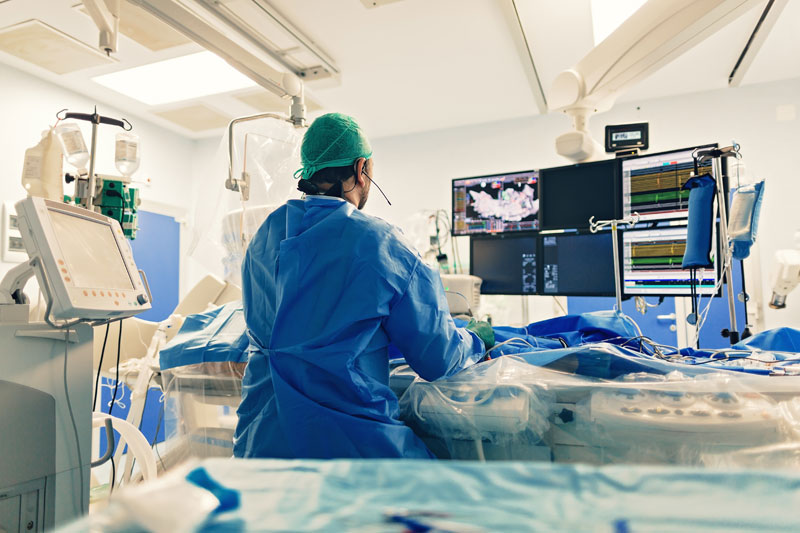Global interventional radiology market size was valued at USD 24.20 billion in 2023, driven primarily by the rising incidence of geriatric population across the globe. This demographic shift has significantly increased the demand for minimally invasive procedures, which are at the core of interventional radiology. The market is expected to grow at a compound annual growth rate (CAGR) of 6.7% during the forecast period of 2024-2032, reaching an estimated value of USD 43.37 billion by 2032. This article explores the dynamics driving this market growth, emerging trends, market segmentation, and the future landscape of the global interventional radiology market.
Understanding Interventional Radiology
What is Interventional Radiology?
Interventional radiology (IR) is a specialized branch of radiology that uses imaging technologies such as X-ray, CT scans, MRI, and ultrasound to guide minimally invasive surgical procedures. These procedures are used to diagnose and treat various medical conditions, including vascular diseases, cancers, and non-vascular diseases. The minimally invasive nature of IR procedures reduces patient recovery times, minimizes pain, and lowers the risk of complications compared to traditional surgical methods.
Importance of Interventional Radiology in Modern Healthcare
Interventional radiology has become an integral part of modern healthcare due to its ability to offer precise, image-guided treatments that are less invasive than traditional surgeries. This approach is particularly beneficial for elderly patients and those with complex health conditions who may not be suitable candidates for conventional surgery. IR procedures are used across various medical specialties, including oncology, cardiology, urology, and neurology, making it a versatile and essential tool in patient care.
Global Interventional Radiology Market Dynamics
Drivers
- Rising Incidence of Geriatric Population: One of the primary drivers of the interventional radiology market is the growing geriatric population worldwide. As people age, they are more prone to chronic diseases such as cardiovascular disorders, cancer, and arthritis, which often require minimally invasive treatments. The increased prevalence of these conditions has led to a higher demand for interventional radiology procedures, which are safer and more effective for elderly patients.
- Growing Prevalence of Chronic Diseases: The rising prevalence of chronic diseases, including cancer, cardiovascular diseases, and liver diseases, is driving the demand for interventional radiology. These conditions often require diagnostic and therapeutic procedures that can be performed using interventional radiology, such as angioplasty, embolization, and tumor ablation. The increasing incidence of these diseases is boosting the market for interventional radiology.
- Advancements in Imaging Technologies: Technological advancements in imaging technologies, such as high-definition imaging, 3D imaging, and real-time image guidance, have significantly enhanced the accuracy and effectiveness of interventional radiology procedures. These innovations have improved patient outcomes and expanded the range of conditions that can be treated using minimally invasive techniques, driving market growth.
- Rising Demand for Minimally Invasive Procedures: There is a growing preference for minimally invasive procedures among patients and healthcare providers due to the numerous benefits they offer, including reduced pain, shorter hospital stays, quicker recovery times, and lower healthcare costs. Interventional radiology is at the forefront of minimally invasive treatments, making it a preferred choice for many medical conditions.
- Increasing Healthcare Expenditure: Rising healthcare expenditure, particularly in emerging economies, is supporting the expansion of the interventional radiology market. Governments and private sector players are investing in healthcare infrastructure, including advanced imaging technologies and minimally invasive treatment facilities, to improve access to quality care and enhance patient outcomes.
Restraints
- High Cost of Equipment and Procedures: Despite its numerous advantages, the high cost of interventional radiology equipment and procedures can be a barrier to market growth, particularly in low- and middle-income regions. The initial investment in advanced imaging technologies and the cost of specialized training for healthcare providers can limit the adoption of interventional radiology in some healthcare settings.
- Lack of Skilled Professionals: The successful implementation of interventional radiology procedures requires highly skilled professionals with expertise in both radiology and surgery. However, there is a shortage of trained interventional radiologists in many regions, which can hinder the growth of the market. Ensuring the availability of skilled professionals through education and training programs is essential for the continued expansion of interventional radiology.
- Regulatory Challenges: The regulatory environment for medical devices and procedures varies by region and can present challenges for the adoption of new interventional radiology technologies. Ensuring compliance with safety and efficacy standards, obtaining approvals, and navigating complex regulatory processes can be time-consuming and costly for manufacturers and healthcare providers.
External Global Interventional Radiology Market Trends
Increasing Adoption of Image-Guided Procedures
The adoption of image-guided procedures is a significant trend influencing the interventional radiology market. These procedures allow for real-time visualization of the treatment area, enhancing the precision and safety of interventions. As imaging technologies continue to advance, the range of conditions that can be treated using interventional radiology is expanding, driving market growth.
Growth of Hybrid Operating Rooms
The growth of hybrid operating rooms, which combine surgical and imaging capabilities in a single space, is another trend driving the interventional radiology market. Hybrid ORs enable healthcare providers to perform complex procedures that require both surgical and interventional radiology techniques, improving patient outcomes and reducing the need for multiple surgeries.
Focus on Personalized Medicine
There is a growing focus on personalized medicine in the healthcare sector, and interventional radiology is playing a key role in this shift. Personalized medicine involves tailoring treatments to the individual characteristics of each patient, such as their genetic makeup, disease type, and overall health. Interventional radiology offers targeted treatments that can be customized to meet the specific needs of each patient, making it a valuable tool in personalized medicine.
Expansion of Telemedicine and Remote Monitoring
The expansion of telemedicine and remote monitoring is enhancing the accessibility of interventional radiology services, particularly in remote or underserved areas. Telemedicine enables healthcare providers to remotely consult with patients, review imaging results, and guide interventional procedures from a distance. This trend is expected to continue, improving access to specialized care and driving market growth.
Increasing Use of Artificial Intelligence and Machine Learning
The integration of artificial intelligence (AI) and machine learning (ML) in interventional radiology is enhancing the accuracy and efficiency of procedures. AI-powered imaging analysis can assist radiologists in identifying abnormalities, planning interventions, and predicting patient outcomes. The use of AI and ML is expected to grow, driving innovation and improving the quality of care in interventional radiology.
Global Interventional Radiology Market Segmentation
By Product Type
- Ablation Devices: Ablation devices are used to destroy abnormal tissues, such as tumors or vascular malformations, using heat, cold, or other energy sources. These devices are commonly used in interventional oncology and vascular procedures, making them a significant segment of the interventional radiology market.
- Angiography Systems: Angiography systems are imaging technologies used to visualize blood vessels and guide vascular interventions, such as angioplasty and stenting. These systems are essential for diagnosing and treating cardiovascular diseases, making them a key component of interventional radiology.
- Embolization Devices: Embolization devices are used to block blood flow to specific areas of the body, such as tumors or aneurysms. These devices are commonly used in interventional oncology and vascular procedures, and their use is expanding as the range of treatable conditions grows.
Media Contact - Company Name: Claight Corporation
- Contact Person: James William, Corporate Sales Specialist
- Email: sales@expertmarketresearch.com
- Toll Free Number: +1-415-325-5166 | +44-702-402-5790
- Address: 30 North Gould Street, Sheridan, WY 82801, USA
- Website: www.expertmarketresearch.com
Related Post :- Maximizing lazer efficiency


